Презентация к уроку обучение грамоте предложение и слово 1 класс: Презентация к уроку обучения грамоте 1 класс на тему «Слово и предложение»!
Описание презентации по отдельным слайдам:
1 слайд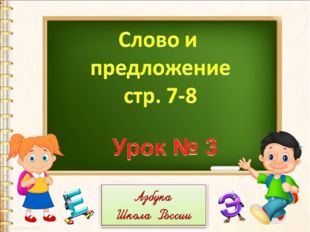 Описание слайда: 2 слайд
Описание слайда: 2 слайд  Описание слайда: 3 слайд
Описание слайда: 3 слайд 
Задай вопросы к картинке.
4 слайд Описание слайда:
Описание слайда:Подумай, правильно ли поступает мальчик?
5 слайд Описание слайда:
Описание слайда:Кто здесь лишний?
6 слайд Описание слайда:
Описание слайда:Кто здесь лишний?
7 слайд Описание слайда:
Описание слайда:Кто здесь лишний?
8 слайд Описание слайда:
Описание слайда: Описание слайда:
Описание слайда:I__________ __________ . Составь предложение и схему состоящую из двух слов.
10 слайд Описание слайда:
Описание слайда: I________ _________ _________ . Составь предложение и схему предложения из трёх слов.
11 слайд Описание слайда:
Описание слайда:I________ _________ _________ . Составь предложение по схеме.
12 слайд Описание слайда:
Описание слайда: Описание слайда: 14 слайд
Описание слайда: 14 слайд 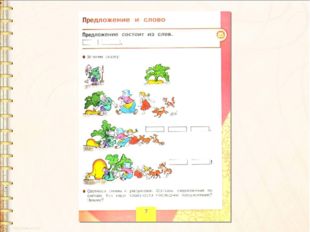 Описание слайда: 15 слайд
Описание слайда: 15 слайд  Описание слайда: 16 слайд
Описание слайда: 16 слайд 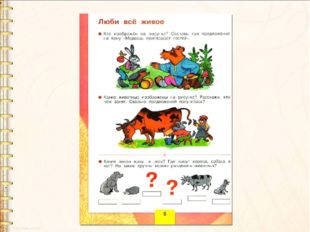 Описание слайда: 17 слайд
Описание слайда: 17 слайд 
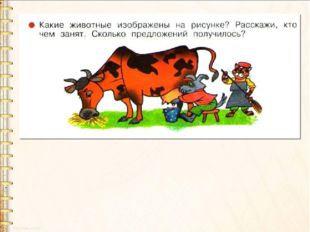 Описание слайда: 19 слайд
Описание слайда: 19 слайд  Описание слайда: 20 слайд
Описание слайда: 20 слайд  Описание слайда: 21 слайд
Описание слайда: 21 слайд 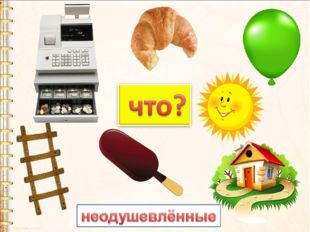 Описание слайда: 22 слайд
Описание слайда: 22 слайд 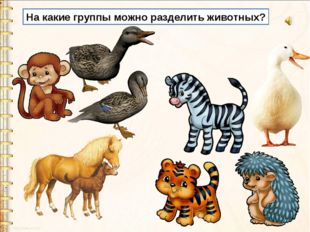
На какие группы можно разделить животных?
23 слайд Описание слайда:
Описание слайда:Найди лишний предмет.
24 слайд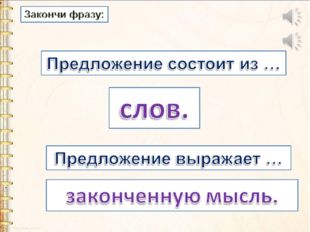 Описание слайда: 25 слайд
Описание слайда: 25 слайд 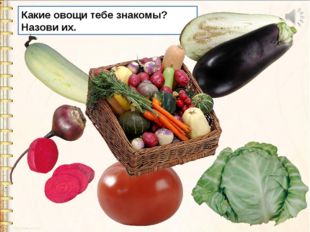 Описание слайда:
Описание слайда:Какие овощи тебе знакомы? Назови их.
26 слайд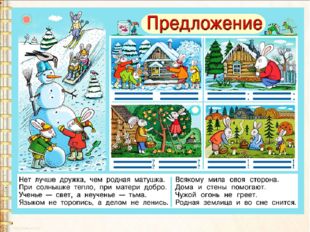 Описание слайда: 27 слайд
Описание слайда: 27 слайд 
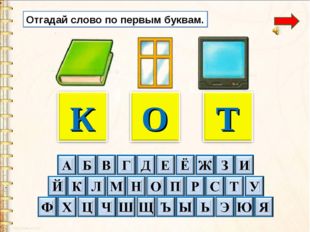 Описание слайда:
Описание слайда:Отгадай слово по первым буквам.
29 слайд Описание слайда: 30 слайд
Описание слайда: 30 слайд 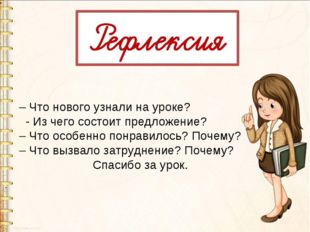 Описание слайда:
Описание слайда:– Что нового узнали на уроке? — Из чего состоит предложение? – Что особенно понравилось? Почему? – Что вызвало затруднение? Почему? Спасибо за урок.
31 слайд Описание слайда:
Описание слайда:Оцените себя Зелёный цвет- всё понял, могу идти дальше. Жёлтый цвет- ещё ошибаюсь. Красный цвет- стоп! Мне нужна помощь!
32 слайд Описание слайда:
Описание слайда:Плакаты сайта Дрофа: http://www.drofa.ru/files/presentations/visual/Contents/Rus_Nach/01.htm

Курс профессиональной переподготовки
Учитель начальных классов

Курс повышения квалификации

Курс повышения квалификации
Найдите материал к любому уроку,
указав свой предмет (категорию), класс, учебник и тему:
Выберите категорию: Все категорииАлгебраАнглийский языкАстрономияБиологияВнеурочная деятельностьВсеобщая историяГеографияГеометрияДиректору, завучуДоп. образованиеДошкольное образованиеЕстествознаниеИЗО, МХКИностранные языкиИнформатикаИстория РоссииКлассному руководителюКоррекционное обучениеЛитератураЛитературное чтениеЛогопедия, ДефектологияМатематикаМузыкаНачальные классыНемецкий языкОБЖОбществознаниеОкружающий мирПриродоведениеРелигиоведениеРодная литератураРодной языкРусский языкСоциальному педагогуТехнологияУкраинский языкФизикаФизическая культураФилософияФранцузский языкХимияЧерчениеШкольному психологуЭкологияДругое
Выберите класс: Все классыДошкольники1 класс2 класс3 класс4 класс5 класс6 класс7 класс8 класс9 класс10 класс11 класс
Выберите учебник: Все учебники
Выберите тему: Все темы
также Вы можете выбрать тип материала:

Общая информация
Номер материала: ДБ-183870
Похожие материалы
Вам будут интересны эти курсы:
Оставьте свой комментарий
Описание презентации по отдельным слайдам:
1 слайд Описание слайда: 2 слайд
Описание слайда: 2 слайд  Описание слайда: 3 слайд
Описание слайда: 3 слайд  Описание слайда:
Описание слайда:Задай вопросы к картинке.
4 слайд Описание слайда:
Описание слайда:Подумай, правильно ли поступает мальчик?
5 слайд Описание слайда:
Описание слайда:Кто здесь лишний?
6 слайд Описание слайда:
Описание слайда:Кто здесь лишний?
7 слайд Описание слайда:
Описание слайда:Кто здесь лишний?
8 слайд Описание слайда: 9 слайд
Описание слайда: 9 слайд  Описание слайда:
Описание слайда:I__________ __________ . Составь предложение и схему состоящую из двух слов.
10 слайд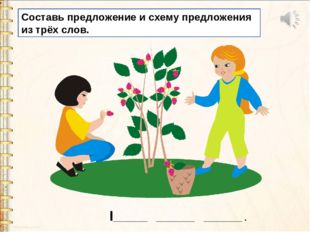 Описание слайда:
Описание слайда:I________ _________ _________ . Составь предложение и схему предложения из трёх слов.
11 слайд Описание слайда:
Описание слайда:I________ _________ _________ . Составь предложение по схеме.
12 слайд Описание слайда:
Описание слайда:I__________ __________ . Составь предложение по схеме.
13 слайд Описание слайда: 14 слайд
Описание слайда: 14 слайд  Описание слайда: 15 слайд
Описание слайда: 15 слайд 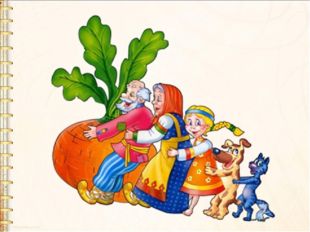 Описание слайда: 16 слайд
Описание слайда: 16 слайд  Описание слайда: 17 слайд
Описание слайда: 17 слайд 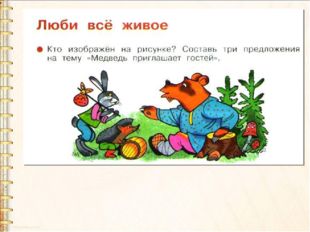 Описание слайда: 18 слайд
Описание слайда: 18 слайд  Описание слайда: 19 слайд
Описание слайда: 19 слайд  Описание слайда: 20 слайд
Описание слайда: 20 слайд 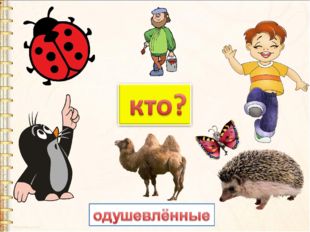 Описание слайда: 21 слайд
Описание слайда: 21 слайд  Описание слайда: 22 слайд
Описание слайда: 22 слайд  Описание слайда:
Описание слайда:На какие группы можно разделить животных?
23 слайд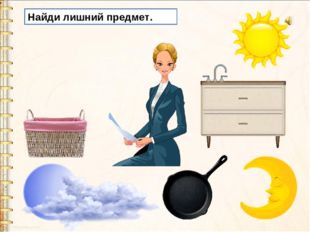 Описание слайда:
Описание слайда:Найди лишний предмет.
24 слайд Описание слайда: 25 слайд
Описание слайда: 25 слайд  Описание слайда:
Описание слайда:Какие овощи тебе знакомы? Назови их.
26 слайд Описание слайда: 27 слайд
Описание слайда: 27 слайд 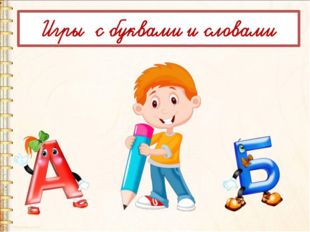 Описание слайда: 28 слайд
Описание слайда: 28 слайд  Описание слайда:
Описание слайда:Отгадай слово по первым буквам.
29 слайд Описание слайда: 30 слайд
Описание слайда: 30 слайд  Описание слайда:
Описание слайда:– Что нового узнали на уроке? — Из чего состоит предложение? – Что особенно понравилось? Почему? – Что вызвало затруднение? Почему? Спасибо за урок.
31 слайд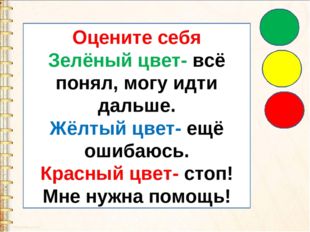 Описание слайда:
Описание слайда:Оцените себя Зелёный цвет- всё понял, могу идти дальше. Жёлтый цвет- ещё ошибаюсь. Красный цвет- стоп! Мне нужна помощь!
32 слайд Описание слайда:
Описание слайда:Плакаты сайта Дрофа: http://www.drofa.ru/files/presentations/visual/Contents/Rus_Nach/01.htm

Курс профессиональной переподготовки
Учитель начальных классов

Курс повышения квалификации

Курс повышения квалификации
Найдите материал к любому уроку,
указав свой предмет (категорию), класс, учебник и тему:
Выберите категорию: Все категорииАлгебраАнглийский языкАстрономияБиологияВнеурочная деятельностьВсеобщая историяГеографияГеометрияДиректору, завучуДоп. образованиеДошкольное образованиеЕстествознаниеИЗО, МХКИностранные языкиИнформатикаИстория РоссииКлассному руководителюКоррекционное обучениеЛитератураЛитературное чтениеЛогопедия, ДефектологияМатематикаМузыкаНачальные классыНемецкий языкОБЖОбществознаниеОкружающий мирПриродоведениеРелигиоведениеРодная литератураРодной языкРусский языкСоциальному педагогуТехнологияУкраинский языкФизикаФизическая культураФилософияФранцузский языкХимияЧерчениеШкольному психологуЭкологияДругое
Выберите класс: Все классыДошкольники1 класс2 класс3 класс4 класс5 класс6 класс7 класс8 класс9 класс10 класс11 класс
Выберите учебник: Все учебники
Выберите тему: Все темы
также Вы можете выбрать тип материала:

Общая информация
Номер материала: ДБ-099450
Похожие материалы
Вам будут интересны эти курсы:
Оставьте свой комментарий
Урок по обучению грамоте в 1 классе
Тема: Предложение и слово.
Цель: закрепить знания учащихся о том, что предложения состоят из слов; развивать речь, умение логически мыслить.
Оборудование: учебник, карточки с изображением животных.
Ход урока
I. Организационный момент.
II. Актуализация опорных знаний.
На прошлом уроке мы узнали, что такое устная и письменная речь.
Из чего состоит наша речь?
С помощью чего мы научились изображать предложения?
Укажите предметы письменной речи.
III.Мотивация учебной деятельности.
На доске начерчена схема:

Вопрос:
– Определите, о чем мы будем говорить сегодня на уроке. (О предложениях и словах; о том, что предложения состоят из слов.)
Логическое упражнение.
▲ Отгадывание загадок:
Он всю зиму в шубе спал,
Лапу бурую сосал,
А проснувшись, стал реветь.
Это зверь лесной … .
(Медведь.)
Шубка-иголка,
Свернется он – колкий,
Рукой не возьмешь.
Кто это? …
(Еж.)
Сама пестрая,
Ест зеленое,
Дает белое.
(Корова.)
Гладишь – ласкается,
Дразнишь – кусается.
(Собака.)
Работа по учебнику: с. 10.
Вопросы:
– Почему животных разделили на две группы? (Дикие и домашние.)
– Назовите диких животных. (Медведь, ёжик – дикие животные. Дикие животные живут в лесу, в поле, сами добывают себе еду.)
– Каких диких животных вы еще знаете?
– Назовите домашних животных. (Корова, собака – домашние животные; за ними ухаживает человек.)
– Каких домашних животных вы еще знаете?
Физкультминутка
Работа по учебнику: с. 10.
Составление рассказов по картинке о корове, собаке, коте.
Вопросы:
– Что вы видите на картинке?
– Что делает собака?
– Что делает корова?
– Что делает кот?
Из прослушанных рассказов учитель выбирает несколько предложений, состоящих из двух-трех слов (предложения, в состав которых входят предлоги, для анализа не используются).
Составляются учащимися схемы этих предложений.
Собака доит корову. ( .)
.)
Корова ест сено. ( .)
.)
Кот подметает. ( .)
.)
Физкультминутка
Работа по учебнику: с. 10.
Составление рассказа по картинке о медведе, зайце и еже.
Вопросы:
– Что вы видите на картинке?
– Кто принимает гостей?
– Кто пришел к медведю в гости?
– Что принесли заяц и ёжик?
– Какое настроение у медведя?
Медведь принимал гостей. Он увидел зайца и ежа. Они принесли гостинец. Медведь был доволен.
III. Итог урока. Рефлексия.
– Чем полезным занимались на уроке?
– Что особенно понравилось? Почему?
– Что вызвало затруднение? Почему?
Продолжите фразу: «Предложение состоит из…»
Спасибо за урок.
Урок по обучению грамоте
«Предложение» 1 класс
09:25-10:00
Работу выполнила учитель начальных классов: Коршунова В.В.
Ход урока:
1. Организационный момент
Уч-ль: Начался урок. Проверьте, на столах должен быть пенал, цветные карандаши, учебник, прописи. Сложите все аккуратно на край стола. Спинка ровно, ручки вместе.
2. Актуализация знаний.
Уч-ль: Чему научились на прошлом уроке? (Слайд 1)
Уч-ся: Работать с учебником, читать его условные обозначения, различали устную и письменную речь.
Уч-ль: (Слайд 2) Как называется речь, если она записана? (письменная)
Уч-ль: (Слайд 3) Как называется речь, если она не записана? (устная речь)
Уч-ль: Для чего служит речь? (для общения, для передачи информации, чувств).
Уч-ль: Откройте азбуку на стр. 4. Расскажите, что вы видите? (дети пришли в школу, их встречает учительница).
Уч-ль: Какой день изобразил художник? (1 сентября, потому что дети нарядные, с цветами).
Уч-ль: Какое у всех настроение? (радостное)
Уч-ль: Как называется речь, которую мы сейчас используем? (устная речь)
Молодцы!
3. Работа с прописями.
Уч-ль: (Слайд 4) Откройте прописи на стр. 6. Возьмите в руки ручку. Посмотрите, как правильно ее держать. Напишите по образцу элементы букв в строчках под рисунками.
4. Физкультминутка.
5. Работа по теме урока.
Уч-ль: Устная речь делится на части. Эти части называются предложениями. Каждое предложение выражает какую-то мысль или важную информацию.
Уч-ль: Например, предложение: «Дети пришли в школу».
Уч-ль: Кто пришел в школу? (дети)
Уч-ль: А еще что мы знаем, куда пришли дети? (в школу)
Уч-ль: Наше предложение можно расширить: «нарядные дети пришли в школу с цветами».
Уч-ль: (Слайд 5) Вот так предложения изображаются графически. Прямоугольник, как коробочка, а внутри слова. В начале — черточка сверху, как будто носик кто-то вытащил из коробочки. А в конце предложения обязательно ставится точка.
Уч-ль: Давайте составим предложения: (Слайд 6)1. Мальчик играет в футбол. (Слайд 7) 2. Мальчик спит.
6. Подведение итогов урока.
Уч-ль: Чему научились на уроке? (Узнали, что такое предложение и как оно обозначается графически)
Уч-ль: Что мы ставим в конце предложения? (точку)
Уч-ль: Понравился вам урок? (Да/нет, не очень)
Уч-ль: Молодцы! Урок окончен!
Описание презентации по отдельным слайдам:
1 слайд Описание слайда: 2 слайд
Описание слайда: 2 слайд  Описание слайда: 3 слайд
Описание слайда: 3 слайд  Описание слайда:
Описание слайда:Составь и запиши предложение о малышах. Найди существительные и глаголы. Малыши играют в игрушки.
4 слайд Описание слайда: 5 слайд
Описание слайда: 5 слайд  Описание слайда:
Описание слайда:Кошка спит на крыльце. Наступила весна. В портфеле лежит пенал. Наступили холода. Пушистый снег покрыл землю. Малыши весело катаются с горы. Подумай чем отличаются эти записи?
6 слайд Описание слайда:
Описание слайда:Страницы 9 -11
7 слайд Описание слайда: 8 слайд
Описание слайда: 8 слайд  Описание слайда: 9 слайд
Описание слайда: 9 слайд  Описание слайда: 10 слайд
Описание слайда: 10 слайд  Описание слайда:
Описание слайда:Вспомните весенние месяцы. Ручейки бегут быстрее, Светит солнышко теплее. Воробей погоде рад — Заглянул к нам месяц …
11 слайд Описание слайда:
Описание слайда:Мишка вылез из берлоги, Грязь и лужи на дороге, В небе жаворонка трель В гости к нам пришёл …
12 слайд Описание слайда:
Описание слайда:Сад примерил белый цвет, Соловей поет сонет, В зелень наш оделся край Нас теплом встречает …
13 слайд Описание слайда:
Описание слайда:Запишите названия весенних месяцев. Постарайтесь запомнить, как они пишутся.
14 слайд Описание слайда: 15 слайд
Описание слайда: 15 слайд  Описание слайда: 16 слайд
Описание слайда: 16 слайд  Описание слайда:
Описание слайда:Найди предложения. Запиши их. Мальчик, девочка, машинка. Арина играет с куклой. Дима катается на лошадке. Ёлка, дети, дерево. Егор играет с котом Барсиком.
17 слайд Описание слайда:
Описание слайда:Какие задания вызвали затруднения? Что нового вы узнали на уроке? Чем отличается текст от группы предложений? Из чего состоит предложение? А текст?
18 слайд Описание слайда: 19 слайд
Описание слайда: 19 слайд  Описание слайда:
Описание слайда: 
Курс профессиональной переподготовки
Учитель начальных классов

Курс повышения квалификации

Курс повышения квалификации
Найдите материал к любому уроку,
указав свой предмет (категорию), класс, учебник и тему:
Выберите категорию: Все категорииАлгебраАнглийский языкАстрономияБиологияВнеурочная деятельностьВсеобщая историяГеографияГеометрияДиректору, завучуДоп. образованиеДошкольное образованиеЕстествознаниеИЗО, МХКИностранные языкиИнформатикаИстория РоссииКлассному руководителюКоррекционное обучениеЛитератураЛитературное чтениеЛогопедия, ДефектологияМатематикаМузыкаНачальные классыНемецкий языкОБЖОбществознаниеОкружающий мирПриродоведениеРелигиоведениеРодная литератураРодной языкРусский языкСоциальному педагогуТехнологияУкраинский языкФизикаФизическая культураФилософияФранцузский языкХимияЧерчениеШкольному психологуЭкологияДругое
Выберите класс: Все классыДошкольники1 класс2 класс3 класс4 класс5 класс6 класс7 класс8 класс9 класс10 класс11 класс
Выберите учебник: Все учебники
Выберите тему: Все темы
также Вы можете выбрать тип материала:

Общая информация
Номер материала: ДБ-160336
Похожие материалы
Вам будут интересны эти курсы:
Оставьте свой комментарий
По теме: методические разработки, презентации и конспекты
Презентация «Слово и предложение»Презентация к уроку русского языка 2 класс по программе «Школа России»…
Связь слов в предложении. Развитие умения ставить вопросы от слова к слову в предложении.1.Переводить информацию из одной формы в другую (схемы), упорядочивать её (строить алгоритмы рассуждений). 2.Дальнейшее обогащение сло…
 Конспект урока и презентация «Слово и предложение».
Конспект урока и презентация «Слово и предложение».Развивающая программа Л.В. Занкова…
 Презентация «Слово и предложение»
Презентация «Слово и предложение»Презентация предназначена для уроков русского языка в 1 классе….
 Заглавная буква в словах и предложениях. Развитие осознанности и правильности чтения. Развитие умения писать заглавную букву в словах и предложениях.
Заглавная буква в словах и предложениях. Развитие осознанности и правильности чтения. Развитие умения писать заглавную букву в словах и предложениях. Формируем умение овладевать начертаниями письменных букв, слов, предложений; умение списывать с печатного образца;умение различать гласные и согласные звуки, гласные ударные и безударные, согласные тв…
 Презентация к уроку русского языка. «Предложение. Связи слов в предложении». 3 класс. СРО Занкова.
Презентация к уроку русского языка. «Предложение. Связи слов в предложении». 3 класс. СРО Занкова.Презентация «Путешествие в зимний лес», уроку русского языка. «Предложение. Связи слов в предложении. 3 класс. СРО Занкова….
 Предложение как единица речи. Границы предложения. Связь слов в предложении.
Предложение как единица речи. Границы предложения. Связь слов в предложении.Научить различать предложение, от набора слов, показать необходимость согласования слов в предложении, упражнять в грамматически правильном построении предложений….
Слайд 1
Тема урока: Летом в деревне. Цель: понимать на слух информацию, содержащуюся в устном высказывании. Презентацию подготовила учитель начальных классов Черемисина Оксана ИвановнаСлайд 4
Вигвам ВИГВА́М — жилище индейцев Северной Америки: хижина, покрытая кожей, корой, ветвями. Когда человек впервые стал искать ночлег, он вынужден был заселять любые защищенные места, которые находил под деревьями, скалами, пещерах. В смертельной борьбе со стихией первые люди учились укутываться в звериные шкуры для того, чтобы согреться. Вскоре кто-то обнаружил, что из этих же шкур можно сделать удобное убежище, если накинуть их на ветви или на простое сооружение типа каркаса .
Слайд 5
Вагончик
Слайд 6
Хижина Небольшой бедный домик
Слайд 7
Иглу Иглу– так называется эскимосская хижина, построенная из снега. Это купол в человеческий рост, состоящий из снежных блоков и низко пропиленной «дверью». Чтобы согреть воздух внутри достаточно одной маленькой свечки. Чтобы легче дышалось, в куполе пробивается отверстие. Напротив этого отверстия устраивают лежанку из снежных блоков.
Слайд 8
Коттедж
Слайд 9
Какое общее слово для всех построек? Можно ли назвать все эти предметы жилищами? Как по-другому можно назвать жилище? дом домик домишко домище Какие ещё слова можно образовать от слова дом ? домашний домовитый домосед домочадцы домовой
Слайд 10
Гном и дом. Жил да был весёлый гном. Он в лесу построил … . Рядом жил поменьше гномик. Под кустом он сделал … . Самый маленький гномишко Под грибом сложил … . Старый, мудрый гном-гномище Выстроил большой… . Был он стар, и был он сед, И большой был … . А за печкой,за трубой Жил у гнома … . Очень строгий, деловитый, Аккуратный, … . Мох, калину,зверобой- Всё из леса нёс … . Есть любил он суп вчерашний, Пил он только квас… . Вечером привык встречаться Гном с любимым … . Вместе посмотреть кино, Поиграть с ним в домино. Каждый день соседи-гномы Навещали деда … . Всех встречал радушно гном, Все любили этот … .
90000 English ESL Powerpoint presentations — Most downloaded (10986 Results) 90001 90002 Grammar Adjectives Adjectives to describe feelings / mood / tone Adjectives to describe personality and character Adjectives with -ed or -ing Adjectives: Gradable / Non-gradable adjectives Adjectives: Incomparable adjectives Adjectives : Opposites adjectives: Order of adjectives adverbs adverbs of degree adverbs of frequency adverbs of manner adverbs of place adverbs of time adverbs: Intensifiers adverbs: Order of adverbs Apostrophe S Articles Articles: definite articles (the) Articles: indefinite articles (a / an) Articles: zero article Auxiliary verbs Backshift in time (e.g. WILL / WOULD) BE (auxiliary verb) BE + infinitive structures (eg he was to become famous) BE ABLE TO BE: WAS or WERE CAN CAN or BE ABLE TO CAN or COULD Causative Clauses of contrast (eg although, while) Clauses of purpose (eg in order to, so that, so as to) Clauses of reason (eg because, because of, due to, as, since) Clauses of result (eg so) Cleft sentences (eg It’s Joey we’re looking for) Commands (imperatives) Comparison (comparative and superlative) Comparison: Comparative adjectives and structures Comparison: Superlative adjectives and structures Comparisons: AS or THAN Conditional 0 (zero) Conditional 1 (first conditional) Conditional 2 (second conditional) — would Conditional 3 (third conditional) Conditionals Conditionals — I wish / If only Conditionals — Mixed conditionals Conditionals: Conditional phrases (e.g. unless, provided that, as long as) Conjunctions (aka connectives, eg and, but, or, so, then) Consonants and vowels Contractions (shortened forms, eg do not, are not, etc.) Coordination Countable and uncountable nouns Determiners (words that can come before nouns) Discourse markers DO or DOES Ellipsis (omission of words) Exclamations FEW or A FEW, LITTLE or A LITTLE Figures of speech, metaphors, metonyms Formal and informal English (politeness or colloquial language) Future continuous tense : (will be V + ing) Future perfect continuous (progressive) tense Future perfect simple and continuous (progressive) tense Future perfect simple tense Future phrases (e.g. be about to, bound to, likely to, due to, set to + INF) Future simple tense expressed with WILL Future simple vs future continuous 90003.90000 Student presentations | TeachingEnglish | British Council 90001 90002 90003 Why I get students to do presentations 90004 90005 90002 90003 Planning a presentation lesson 90004 90005 90010 90011 Why I get students to do presentations 90012 90013 Presentations are a great way to have students practise all language systems areas (vocabulary, grammar, discourse and phonology) and skills (speaking, reading, writing and listening). They also build confidence, and presenting is a skill that most people will need in the world of work.I find that students who are good presenters are better communicators all round, since they are able to structure and express their ideas clearly. 90014 90002 90003 Presentation skills are extremely useful both in and outside the classroom. After completing a project, a presentation is a channel for students to share with others what they have learned. It is also a chance to challenge and expand on their understanding of the topic by having others ask questions. And in the world of work, a confident presenter is able to inform and persuade colleagues effectively.90004 90005 90002 90003 Presentations can also form a natural part of task based learning. By focussing on a particular language point or skill, the presentation is a very practical way to revise and extend book, pair and group work. The audience can also be set a task, for example, a set of questions to answer on the presentation, which is a way of getting students to listen to each other. 90004 90005 90010 90011 Syllabus fit 90012 90013 Normally the presentation will come towards the end of a lesson or series of lessons that focus on a particular language or skill area.It is a type of freer practice. This is because the students need to feel relatively confident about what they are doing before they stand up and do it in front of other people. If I have been teaching the past simple plus time phrases to tell a story, for example, I give my students plenty of controlled and semi controlled practice activities, such as gapfills, drills and information swaps before I ask them to present on, say, an important event in their country’s history, which involves much freer use of the target grammar point.90014 90010 90011 Planning a presentation lesson 90012 90013 Normally a presentation lesson will have an outline like this: 90014 90002 90003 Revision of key language areas 90004 90005 90002 90003 Example presentation, which could be from a textbook or given by the teacher 90004 90005 90002 90003 Students are given a transcript or outline of the presentation 90004 90005 90002 90003 Students identify key stages of the example presentation — greeting, introduction, main points in order of importance, conclusion 90004 90005 90002 90003 Focus on linking and signalling words ( ‘Next …’, ‘Now I’d like you to look at …’, etc.). Students underline these in the transcript / place them in the correct order 90004 90005 90002 90003 Students are put into small groups and write down aims 90004 90005 90002 90003 Students then write down key points which they order, as in the example 90004 90005 90002 90003 Students decide who is going to say what and how 90004 90005 90002 90003 Students prepare visuals (keep the time for this limited as too many visuals become distracting) 90004 90005 90002 90003 Students practise at their tables 90004 90005 90002 90003 Students deliver the presentations in front of the class, with the audience having an observation task to complete (see ‘Assessment’ below) 90004 90005 90002 90003 The teacher takes notes for feedback later 90004 90005 90010 It is important that the students plan and deliver the presentations in groups at first, unless they are extremely confident and / or fluent.This is because: 90014 90002 90003 Shy students can not present alone 90004 90005 90002 90003 Students can support each other before, during and after the presentation 90004 90005 90002 90003 Getting ready for the presentation is a practice task in itself 90004 90005 90002 90003 When you have a large class, it takes a very long time for everyone to present individually! 90004 90005 90010 I find it’s a good idea to spend time training students in setting clear aims. It is also important that as teachers we think clearly about why we are asking students to present.90014 90010 90011 Aims 90012 90013 Presentations normally have one or more of the following aims: 90014 90002 90003 To inform / raise awareness of an important issue 90004 90005 90002 90003 To persuade people to do something 90004 90005 90002 90003 Form part of an exam, demonstrating public speaking / presentation skills in a first or second language 90004 90005 90010 I set students a task where they answer these questions: 90014 90002 90003 Why are you making the presentation? 90004 90005 90002 90003 What do you want people to learn? 90004 90005 90002 90003 How are you going to make it interesting? 90004 90005 90010 Let’s say I want to tell people about volcanoes.I want people to know about why volcanoes form and why they erupt. This would be an informative / awareness-raising presentation. So by the end, everyone should know something new about volcanoes, and they should be able to tell others about them. My plan might look like this: 90014 90002 90003 Introduction — what is a volcano? (2 minutes) 90004 90005 90002 90003 Types of volcano (5 minutes) 90004 90005 90002 90003 Volcanoes around the world (2 minutes) 90004 90005 90002 90003 My favourite volcano (2 minutes) 90004 90005 90010 90011 Classroom Management 90012 90013 I find that presentation lessons pass very quickly, due the large amount of preparation involved.With a class of 20 students, it will probably take at least 3 hours. With feedback and follow-up tasks, it can last even longer. I try to put students into groups of 3 or 4 with classes of up to 20 students, and larger groups of 5 or 6 with classes up to 40. If you have a class larger than 40, it would be a good idea to do the presentation in a hall or even outside. 90014 90010 Classroom management can become difficult during a presentations lesson, especially during the final presenting stage, as the presenters are partly responsible for managing the class! There are a few points I find effective here: 90014 90002 90003 Training students to stand near people who are chatting and talk ‘through’ the chatter, by demonstration 90004 90005 90002 90003 Training students to stop talking if chatter continues, again by demonstration 90004 90005 90002 90003 Asking for the audience’s attention ( ‘Can I have your attention please?’) 90004 90005 90002 90003 Setting the audience an observation task, which is also assessed by the teacher 90004 90005 90002 90003 Limiting the amount of time spent preparing visuals 90004 90005 90002 90003 Arranging furniture so everyone is facing the front 90004 90005 90010 Most of these points are self-explanatory, but I will cover the observation task in more detail in the next section, which deals with assessment.90014 90010 90011 Assessment 90012 90013 The teacher needs to carefully consider the assessment criteria, so that s / he can give meaningful feedback. I usually run through a checklist that covers: 90014 90002 90003 90011 Level 90012 — I can not expect Elementary students to use a wide range of tenses or vocabulary, for example, but I’d expect Advanced students to have clear pronunciation and to use a wide range of vocabulary and grammar 90004 90005 90002 90003 90011 Age 90012 — Younger learners do not (normally) have the maturity or general knowledge of adults, and the teacher’s expectations need to reflect this 90004 90005 90002 90003 90011 Needs 90012 — What kind of students are they? Business English students need to have much more sophisticated communication skills than others.Students who are preparing for an exam need to practise the skills that will be assessed in the exam. 90004 90005 90010 I write a list of language related points I’m looking for. This covers: 90014 90002 90003 Range / accuracy of vocabulary 90004 90005 90002 90003 Range / accuracy of grammar 90004 90005 90002 90003 Presentation / discourse management- is it well structured? What linking words are used and how? 90004 90005 90002 90003 Use of visuals- Do they help or hinder the presentation? 90004 90005 90010 ‘Paralinguistics’ refers to non-verbal communication.This is important in a presentation because eye contact, directing your voice to all parts of the room, using pitch and tone to keep attention and so on are all part of engaging an audience. 90014 90010 I find it’s a good idea to let students in on the assessment process by setting them a peer observation task. The simplest way to do this is to write a checklist that relates to the aims of the lesson. A task for presentations on major historical events might have a checklist like this: 90014 90002 90003 Does the presenter greet the audience? YES / NO 90004 90005 90002 90003 Does the presenter use the past tense? YES / NO 90004 90005 90002 90003 Tick the linking words the presenter uses: 90002 90003 And then … 90004 90003 Next … 90004 90003 Finally … 90004 90005 90004 90005 90010 And so on.This normally helps me to keep all members of the audience awake. To be really sure, though, I include a question that involves personal response to the presentation such as ‘What did you like about this presentation and why?’. If working with young learners, it’s a good idea to tell them you will look at their answers to the observation task. Otherwise they might simply tick random answers! 90014 90010 90011 Conclusion 90012 90013 Presentations are a great way to practise a wide range of skills and to build the general confidence of your students.Due to problems with timing, I would recommend one lesson per term, building confidence bit by bit throughout the year. In a school curriculum this leaves time to get through the core syllabus and prepare for exams. 90014.90000 How to Plan a TEFL Lesson 90001 90002 Why plan lessons? 90003 90004 Every TEFL lesson needs a plan. The level of detail it contains, and whether it is mainly in your head or mainly on paper, will vary depending on your training and experience, the type of class (one-to-one classes often have a much more fluid plan, for example ) and the time that you have available to plan. 90005 90004 The main reason to have a plan for a TEFL lesson is to know, firstly, the aim of your lesson and, secondly, what you’re going to do during the lesson in order to achieve that aim.If you do not know what you want your students to be able to do by the end of the lesson, you risk them going away feeling that they have not achieved anything. 90005 90002 What should a TEFL lesson plan include? 90003 90004 Everything that you might want to include in your plan derives from the main aim and how you’re going to achieve it. What materials do you need for the activities that you’ve planned in order to achieve your aim? How long will each of these activities take? What problems might your students have in dealing with a particular activity or language point? And so on.90005 90004 As we said, for most teachers it is impractical to plan every lesson with this amount of detail. But these kinds of detail should at the very least be in your head, even if the paper version is just a few scribbled lines — and writing a few plans in this way is the best way to get yourself into the habit of thinking about these kinds of detail when you’re planning, even if you do not have the time to actually write them. 90005 90004 Although there are other possibilities, here’s a list of the main things to include in a detailed lesson plan: 90005 90004 Main aim 90017 Subsidiary aims 90017 Personal aims 90017 Materials 90017 Anticipated problems and solutions 90005 90004 And for each stage of the lesson itself: 90005 90004 Timing 90017 Stage aims 90017 Activities 90017 Focus 90005 90004 We’ll have a look at each one more closely.At the end is an example plan for this Used to lesson. 90017 90005 90032 Main aim 90033 90004 What should the main aim be? Ideally it should come from a course plan which outlines a logical progression of aims for every lesson in a course. How does this lesson that you’re teaching today fit into the bigger picture of what your students want or need to achieve on the course? The aim might be based on a language point (grammatical, lexical or phonological), or it might be based on a skill (reading, writing, listening or speaking).90005 90004 The key is to think not in terms of what you want to teach, but in terms of 90037 what you want your students to be able to do 90038. By thinking from your students ‘perspective you are more likely to choose activities which will help them achieve this aim, rather than activities which are easy for you to teach. if your aim is grammar or vocabulary based, you also avoid the risk of «teaching» the form and then thinking «okay, they’ve got it, job done». 90005 90004 So, instead of «to teach will and going to» or «to practice listing for gist» try «to enable students to discuss future plans using will and going to» or «to develop students ‘ability to identify the main ideas in a reading text «.Think along the lines of «90037 to help / to enable / to develop / to improve … 90038» rather than «to teach / to practice». 90005 90004 It’s also a good idea to make a note of how you will recognise when your students have achieved the main aim. This can help you afterwards to critically analyse your lesson, think about ways to improve it if they did not achieve the aim, and decide what further work is needed on a particular language point or skill. 90017 90005 90032 Subsidiary aims 90033 90004 You may also have some secondary aims that you would like to work on.In the «Used to» lesson below the main aim is based on a language point, but we do some listening work to provide the context for presenting this language, so we take the opportunity to develop the students ‘listening skills. We also introduce some vocabulary, not just because we need it to understand the text, but because we would like our students to be able to use this vocabulary outside the lesson. 90017 90005 90032 Personal aims 90033 90004 You might also have something that you want to achieve on a more personal level.Maybe in your last lesson you were not happy with your board work and you want to improve on this. If there are several aspects of your teaching that you want to improve or develop, try focusing on one at a time here — work on it for a few lessons until you’re happy with it, then move on to the next one. 90017 90005 90032 Materials 90033 90004 What materials will you need for each of your activities? Make sure you will not need to run back to the photocopier during the class by going through all the stages of your lesson one by one — have you forgotten anything? 90017 90005 90032 Anticipated problems and solutions 90033 90004 Take a little time to go through the stages of your lesson and anticipate the problems your students may have and what you will do if these problems crop up.Anticipating the unexpected allows you to, as far as is possible, avoid the danger of being left stranded without an answer. This can help you feel more confident and deliver a more effective lesson. 90005 90004 Think in terms of vocabulary in a text that you may have to pre-teach in some way, potential issues with pronunciation and how you’re going to deal with them, possible lack of student imagination in creative tasks, possible confusion of tenses and how you’re going to resolve this, and so on.It’s important to be precise here. If you say «students may be unfamiliar with some words in the text» it does not really help you to prepare a solution. If you say «students may be unfamiliar with the words» to give up, to quit … «, you can think about the best way to present or elicit the meaning of each. 90005 90002 Stages of the lesson 90003 90004 Now we come to the lesson itself. There are four things to consider here: 90017 90005 90032 Timing 90033 90004 Your lesson has a fixed length and so you’ll need to think about the timing of each activity.This helps you to know that you have planned a long enough lesson, and during the lesson itself will serve as a self-check to make sure you achieve what you want to achieve. If you find that you have not planned enough material, make sure any new activities you add contribute to your lesson aim — avoid the temptation to crow-bar in activities that do not really fit. You could also go back and think about the activities you already have — could you expand on them or change them in any way? 90017 90005 90032 Stage aims 90033 90004 These are the aims of the individual stages of your lesson, as opposed to the main aim of the lesson as a whole.There should be a logical progression here towards achieving the main aim. Stage aims should answer the question «Why am I doing this?» rather than «What am I doing?» — the answer to this second question comes in the next column. 90005 90004 The stages that you include in your lesson will depend, of course, on the type of lesson. The «Used to» lesson follows a traditional PPP (presentation, practice, production) model. We therefore expect to see a stage where the language is presented in some way.This could be a situational presentation, a presentation from a text, or one of a number of different techniques to present new language. We also expect to see some practice stages, probably some restricted followed by some freer practice. These stages could be either oral or written. Finally, we expect to see a production stage or, as we have called it in this lesson, authentic practice. 90017 90005 90032 Activity 90033 90004 This is what you actually do at each stage of the lesson. Be specific here.Instead of «Look at and discuss pictures», break it down and say exactly how you’re going to do this: «Students look at photos of children doing things; Students discuss in pairs whether or not they did these things in the past and whether or not they do them now «. Being this specific will help keep you on track and ensure that you do not forget a crucial part of an activity. 90017 90005 90032 Focus 90033 90004 This tells you whether the activity is pair-work (S-S), group work (S-S-S), a teacher-led activity (during the presentation stage, for example — T-Ss) and so on.This can show you whether or not you have a range of different activity types — is your lesson too teacher-centred? Is every activity pairwork? Have you mixed up the groups for different activities? 90017 90017 Here’s the 90037 used to 90038 lesson plan: 90005 90098 90099 90100 90101 90037 Main aim 90038 90104 90105 To develop students ‘ability to talk about past habits using 90037 used to 90038 in the context of childhood and addictions. 90108 90109 90104 90105 Students will, during the less restricted practice stage, use the target language with sufficient accuracy for their partner to understand their past habits.90108 90109 90114 90115 90100 90101 90037 Subsidiary aims 90038 90104 90105 To develop students ‘ability to listen for the main ideas in a text. 90108 90105 To improve students ‘ability to talk about the topic of addictions by introducing an addiction lexical set. 90108 90109 90114 90115 90100 90101 90037 Personal aims 90038 90104 90105 Give students more time to discuss in pairs after a listening activity before feedback. 90108 90109 90114 90115 90100 90101 90037 Materials 90038 90104 90105 Realia — chocolate, cigarettes, coffee, a PC 90108 90105 Pictures or short video clips of children playing on swings, dressing up for Halloween, studying at school.90108 90105 Listening CD and photocopies of tapescript from 90148 Language To Go Intermediate 90149 (Longman, 2002) lesson 11. 90108 90105 Photocopies of handout for each student. 90108 90109 90114 90115 90100 90101 90037 Anticipated problems and solutions 90038 90104 90105 Problem: Students may be unable to think of three things they did as a child but do not do now on the spur of the moment. 90017 Solution: Provide prompts and examples if necessary. 90108 90105 Problem: Students will not be familiar with «to give up», to quit «,» to cut down on «in the listening text.90017 Solution: Elicit these items in the context of addictions. 90108 90105 Problem: Students will be unfamiliar with the pronunciation of «used to» — / juːstə / 90017 Solutuon: Drill in affirmative, negative and question forms 90108 90109 90114 90115 90100 90174 Timing 90175 90174 Aims 90175 90174 Activity 90175 90174 Focus 90175 90115 90100 90184 8 mins 90114 90184 90037 Lead in 90038 90017 to set the context for the lesson and generate interest 90114 90184 90104 90105 Ss look at photos of children doing things 90108 90105 Ss discuss whether or not they did these things in the past and whether or not they do them now 90108 90105 Ss write three things they did as a child but do not do now and give them to T 90108 90109 90114 90184 S-S-S 90114 90115 90100 90184 7 mins 90114 90184 90037 Lexis 90038 90017 to introduce vocabulary for listening stage 90114 90184 90104 90105 Ss look at coffee, cigarettes, chocolate and a PC 90108 90105 Ss discuss whether or not they use these things, how often, and whether they can stop 90108 90105 T elicits addict, addicted, addiction, to quit, to give up, to cut down on, willpower 90108 90109 90114 90184 S-SS-ST-Ss 90114 90115 90100 90184 10 mins 90114 90184 90037 Listening 90038 90017 to practise listening for gist 90114 90184 90104 90105 Ss listen to four people describing their addictions: Does the person have the same addiction as you? If not, what are they addicted to; Have they given up? 90108 90105 Feedback on board 90108 90109 90114 90184 SSs-T 90114 90115 90100 90184 12 mins 90114 90184 90037 Presentation 90038 90104 90105 to introduce target language 90108 90105 to manipulate form 90108 90105 to provide restricted practice in using target language and standardise pronunciation 90108 90109 90114 90184 90104 90105 T elicits target language: — Did he smoke in the past? Yes- Once or many times? Many times- Does he smoke now? No «He used to smoke» 90108 90105 T repeats with other examples and elicits negative and question 90108 90105 T drills target language 90108 90109 90114 90184 Ss-T 90114 90115 90100 90184 10 mins 90114 90184 90037 Less restricted practice 90038 90017 to give students restricted practise in using target language 90114 90184 90104 90105 T writes on board one thing that each student used to do as a child 90108 90105 Ss circulate, asking each other questions to find out who used to do what 90108 90105 Feedback 90108 90109 90114 90184 T-SsS-S-SSs-T 90114 90115 90100 90184 3 mins 90114 90184 90037 Less resticted written practice 90038 90017 to provide a written record of the target language 90114 90184 90104 90105 Sts write 2 sentences about themselves and two about other sts using target language 90108 90105 Feedback 90108 90109 90114 90184 S 90114 90115 90100 90184 10 mins 90114 90184 90037 Authentic practice 90038 90017 to give students authentic practice in using target language 90114 90184 90104 90105 T gives handout with prompts — last house, last job, appearance 10 years ago 90108 90105 Ss circulate and ask and answer questions based on prompts 90108 90105 Feedback 90108 90109 90114 90184 S-S-S 90114 90115 90333 90334 90004 90017 This lesson follows a typical 90037 PPP 90038 (Presentation, Practice, Production) model.With this model we first present or elicit the language in some way. The students then practise it in more or less controlled situations and finally produce it in a more authentic situation. Have a look below for more about these practice and production stages. 90005 90004 PPP is just one of several possible lesson models — as such we have not covered all of the possible lesson stage types and have only touched on some of the terminology that you might include in these stages. But we’ll expand on some of the terminology and stages that we have mentioned in more detail here: 90017 90005 90032 Lead in 90033 90004 A lead in activity is designed to «warm the students up» — to generate interest and get them thinking about the topic.When you introduce a topic, for example with pictures, a video or some questions, you activate in your students ‘minds a mental image or expectation based on their existing knowledge of the topic. This mental image is often called a 90037 schema 90038, and so we can say that the aim of a lead-in stage is to «activate your students ‘schemata». Your students ‘existing knowledge and experience can then be used to personalise the lesson. 90017 90005 90032 Target language 90033 90004 The aim of the presentation stage is to present or elicit the target language — the language that we want the students to be able to use correctly in order to achieve the aim of our lesson.There are different ways to do this — in this case the teacher elicits the meaning of the target language with a series of concept questions before giving the target sentence itself. 90005 90032 Manipulating form 90033 90004 By this we mean that the teacher presents (or elicits) the question and negative forms of the target language, as well as, perhaps, other examples in the first, second or third person. 90017 90005 90032 Restricted / controlled practice 90033 90004 The first practice stage, where the teacher drills the pronunciation of the target language, is very restricted, in the sense that students focus entirely on the sentence containing the target language.There is no opportunity at this stage to incorporate other language. The practice stage of PPP lessons tends to start with restricted practice in this way, and then gradually move on to less restricted and eventually much more authentic practice. 90005 90004 In the less restricted practice stage of this lesson, students are given the chance to circulate and ask each other questions (using the material that was gathered during the lead in). The focus is still very much on the target language, but much less restricted or controlled than the previous exercise.90017 90005 90032 Authentic / Free / Fluency practice 90033 90004 Finally, the students are given the opportunity to produce the target language in a much freer context. The activity in this lesson encourages them to talk about the past, and they may naturally use the target language during their conversations, but they are also free to use other language. There should not be any pressure on the students at this stage to use the target language, and you may find that they do not use it very much at all.This is why we can call this stage 90037 authentic 90038 practice — in an authentic situation we would not use «used to» in every sentence when communicating with someone — we would maybe use it once or twice in addition to other forms. 90017 90005 90004 90037 Written by Keith Taylor 90038 90017 Keith is the founder of Eslbase. He has been an English teacher and teacher trainer for over 15 years. 90005 .90000 English ESL kids Powerpoint presentations 90001 90002 Grammar Adjectives Adjectives to describe feelings / mood / tone Adjectives to describe personality and character Adjectives with -ed or -ing Adjectives: Gradable / Non-gradable adjectives Adjectives: Incomparable adjectives Adjectives: Opposites Adjectives: Order of adjectives adverbs adverbs of degree adverbs of frequency adverbs of manner adverbs of place adverbs of time adverbs: Intensifiers adverbs: Order of adverbs Apostrophe S Articles Articles: definite articles (the) Articles: indefinite articles (a / an) Articles: zero article Auxiliary verbs Backshift in time (e.g. WILL / WOULD) BE (auxiliary verb) BE + infinitive structures (eg he was to become famous) BE ABLE TO BE: WAS or WERE CAN CAN or BE ABLE TO CAN or COULD Causative Clauses of contrast (eg although, while) Clauses of purpose (eg in order to, so that, so as to) Clauses of reason (eg because, because of, due to, as, since) Clauses of result (eg so) Cleft sentences (eg It’s Joey we’re looking for) Commands (imperatives) Comparison (comparative and superlative) Comparison: Comparative adjectives and structures Comparison: Superlative adjectives and structures Comparisons: AS or THAN Conditional 0 (zero) Conditional 1 (first conditional) Conditional 2 (second conditional) — would Conditional 3 (third conditional) Conditionals Conditionals — I wish / If only Conditionals — Mixed conditionals Conditionals: Conditional phrases (e.g. unless, provided that, as long as) Conjunctions (aka connectives, eg and, but, or, so, then) Consonants and vowels Contractions (shortened forms, eg do not, are not, etc.) Coordination Countable and uncountable nouns Determiners (words that can come before nouns) Discourse markers DO or DOES Ellipsis (omission of words) Exclamations FEW or A FEW, LITTLE or A LITTLE Figures of speech, metaphors, metonyms Formal and informal English (politeness or colloquial language) Future continuous tense : (will be V + ing) Future perfect continuous (progressive) tense Future perfect simple and continuous (progressive) tense Future perfect simple tense Future phrases (e.g. be about to, bound to, likely to, due to, set to + INF) Future simple tense expressed with WILL Future simple vs future continuous 90003.
